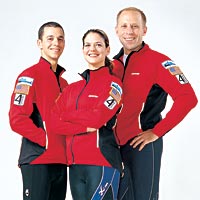|
Photo: Jeff Sciortino |
| Team Illinois: (from left ) Joel Burrows, Nancy Burrows, and Dave Kuhnau |
Running, walking, and crab-crawling across 150 miles worth of prime real estate smack in the middle of the Sahara Desert-in searing heat and without a spot of shade anywhere-might qualify as a pretty dire situation. But for your average extreme-endurance addict, events such as The 4 Deserts, an adventure race spanning three years, make a certain kind of sense. Organized by a company called Racing the Planet, the four-stage amateur competition started with a trek across China’s Gobi desert in 2003, followed by similar journeys across the high-altitude Atacama Desert in Chile and the Sahara in Egypt.
The event’s final leg, a weeklong slog across Antarctica, starts on January 24th and only one team at the starting line will have finished all three previous races: Team Illinois, a Chicago-based trio composed of Nancy and Joel Burrows and Dave Kuhnau. Nancy, 38, is the director of exercise programs at the East Bank Club; her husband, Joel, 30, is a trainer there and Kuhnau, 36, a member. (Participants pay their own travel and equipment costs, and each leg’s entry fee, which is $9,500 for the Antarctica course. EBC has chipped in as a sponsor, as have other local fitness businesses.)
Team Illinois not only finished all three legs of the race held so far, but took first place in the Gobi and the Sahara. Granted, they were the only team to complete the Sahara course, one that Kuhnau says was unusually brutal. “Very seasoned racers were bowing out,” he says. “It was 130 degrees every single day.” Nancy agrees. “It never cooled off, day or night,” she says. “There was nothing to do but sit there and sweat, and then the sand sticks to you even more.” At night, the athletes slept in group tents; during the day, they trekked and collected water at checkpoints along the route, carrying all their food, sleeping bags, clothes, and supplies.
For Joel, the moment of truth came in China’s Gobi desert. “I’ve been doing endurance races for a long time and always know I will hit the wall at some point, but there is usually a recovery,” he says. “This time, I didn’t have anything left in the tank.” Already two months behind in his training due to a knee injury, Joel faltered on the longest day of the race, one that required Team Illinois to cross 60 miles of sand dunes five to six stories high after already having battled water crossings, whipping sand, and huge rocks. “By the time I got to that day, the heat had zapped me to the point where I had a hard time getting food in,” Joel says.
Nancy just remembers the critters: bugs, snakes, and “spiders bigger than your hand” in the Sahara. “They call them camel spiders and they are so aggressive they come running at you,” she recalls. “We were warned vipers had been seen in the area and kind of made light of it, until one of the Egyptians found one less than 50 feet from us.” The Egyptians, locals who were stationed throughout the course at intervals, killed the snake-then ate it on the spot.



